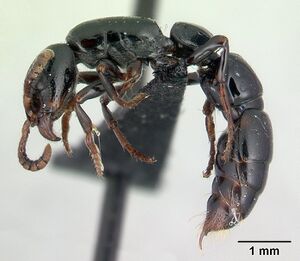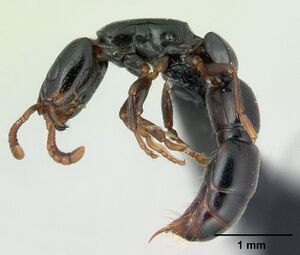Simopone nonnihil
| Simopone nonnihil | |
|---|---|

| |
| Scientific classification | |
| Kingdom: | Animalia |
| Phylum: | Arthropoda |
| Class: | Insecta |
| Order: | Hymenoptera |
| Family: | Formicidae |
| Subfamily: | Dorylinae |
| Genus: | Simopone |
| Species group: | emeryi |
| Species: | S. nonnihil |
| Binomial name | |
| Simopone nonnihil Bolton & Fisher, 2012 | |
Collected as ground foragers, in a dead stick above the ground and on low vegetation in rainforest.
Identification
A member of the emeryi species group.
Keys including this Species
Distribution
Latitudinal Distribution Pattern
Latitudinal Range: -16.82944444° to -16.82944444°.
| North Temperate |
North Subtropical |
Tropical | South Subtropical |
South Temperate |
- Source: AntMaps
Distribution based on Regional Taxon Lists
Malagasy Region: Madagascar (type locality).
Distribution based on AntMaps
Distribution based on AntWeb specimens
Check data from AntWeb
Countries Occupied
| Number of countries occupied by this species based on AntWiki Regional Taxon Lists. In general, fewer countries occupied indicates a narrower range, while more countries indicates a more widespread species. |

|
Estimated Abundance
| Relative abundance based on number of AntMaps records per species (this species within the purple bar). Fewer records (to the left) indicates a less abundant/encountered species while more records (to the right) indicates more abundant/encountered species. |

|
Biology
|
Castes
Worker
Images from AntWeb
   
| |
| Worker. Specimen code casent0066850. Photographer Erin Prado, uploaded by California Academy of Sciences. | Owned by CAS, San Francisco, CA, USA. |
   
| |
| Worker. Specimen code casent0488927. Photographer Erin Prado, uploaded by California Academy of Sciences. | Owned by CAS, San Francisco, CA, USA. |
Nomenclature
The following information is derived from Barry Bolton's Online Catalogue of the Ants of the World.
- nonnihil. Simopone nonnihil Bolton & Fisher, 2012: 58, figs. 61-63 (w.m.) MADAGASCAR.
- Type-material: holotype worker, 2 paratype workers, 1 paratype male.
- Type-locality: holotype Madagascar: Toamasina, Ambohidena, 20 m., 16°49.46’S, 49°57.85’E, 21-24.xi.2005, BLF12984, CASENT0066745-RES, littoral forest (B.L. Fisher); paratypes with same data.
- Type-depository: CASC.
- Distribution: Madagascar.
Unless otherwise noted the text for the remainder of this section is reported from the publication that includes the original description.
Description
Worker
(holotype in parentheses). HL 1.22–1.68 (1.54), HW 0.74–1.16 (0.99), SL 0.34–0.52 (0.45), EL 0.34–0.48 (0.42), PW 0.60–0.92 (0.78), AIIW 0.59–0.88 (0.78), AIIL 0.64–0.90 (0.80), AIIIW 0.68–1.04 (0.92), AIIIL 0.73–1.10 (0.93), WL 1.32–1.86 (1.70), MFL 0.60–1.00 (0.88), CI 61–72 (64), SI 42–46 (45), EL/HW 0.39–0.46 (0.42), EP 0.87–1.12 (1.12), AIIW/AIIL 0.92–1.01 (0.98), AIIIW/AIIIL 0.93–1.01 (0.99) (9 measured).
In full-face view anteriormost points of frontal lobes distinctly project forward as a pair of lobes that extend beyond the level of the anterior clypeal margin. Midpoint of anterior clypeal margin without a convex tumulus, so that the margin is evenly transverse or shallowly convex across. Eyes located close to the cephalic midlength (EP 0.87–1.12). Leading edge of scape with 1–2 projecting setae that are inclined toward the scape apex. In full-face view sides of head without projecting setae. Cephalic dorsum in profile with one, rarely two, short standing setae above the eye; these setae easily lost by abrasion. Ventral surface of head with distinct setae. Cephalic dorsum between eyes with longitudinally directed dense striolate-punctulate ground sculpture between punctures. In dorsal view the pronotum with a transverse carina anteriorly. Propodeal dorsum separated from declivity by a weak, low carina that is interrupted medially. Promesonotal suture weakly impressed and shallowly, evenly curved across the dorsum, not V-shaped medially. Metanotal groove vestigial to absent. Mesosoma in dorsal view narrower across mesonotum than propodeum. Density of punctate sculpture on pronotal and mesonotal dorsa about the same, without a very obvious reduction in density on the mesonotum. Pronotum with a single pair of setae close to the humeri, but these easily lost by abrasion; mesonotum and propodeum without setae. Dorsal (outer) surfaces of mesotibiae and metatibiae without projecting setae, except sometimes for one, close to the apex. Dorsal surface of AII (petiole) meets anterior surface through an angle, but there is no transverse carina. Posteriorly the dorsum of AII lacks a sharp carina, but usually a weak impression is present immediately above the foramen. In dorsal view the posterior corners of AII are bluntly angulate, but without posteriorly or laterally projecting sharp angles or teeth. In dorsal view AII and AIII as long as broad to slightly longer than broad. Abdominal tergites from AII to AIV without setae, but setae sparsely present at least posteriorly on sternite of AIII, and obvious on sternite of AIV. Abdominal tergites AII to AIV sculptured only with small punctures. Full adult colour black, appendages and clypeus somewhat lighter; often with a dull reddish spot on sides of pronotum, AIII and AIV.
Type Material
Holotype worker (upper specimen of two on pin), Madagascar: Toamasina, Ambohidena, 20 m., 16°49.46’S, 49°57.85’E, 21-24.xi.2005, BLF12984, CASENT0066745-RES, littoral forest (B.L. Fisher) (California Academy of Sciences). Paratypes. 1 worker mounted below holotype (crudely dissected); 1 worker and 1 male (abdominal segments behind AII missing) with same data as holotype (California Academy of Sciences).
References
- Bolton, B. & Fisher, B.L. 2012. Taxonomy of the cerapachyine ant genera Simopone Forel, Vicinopone gen. n. and Tanipone gen. n. (Hymenoptera: Formicidae). Zootaxa 3283, 1–101 (doi:10.11646/zootaxa.3283.1.1).
References based on Global Ant Biodiversity Informatics
- Bolton B., and B. L. Fisher. 2012. Taxonomy of the cerapachyine ant genera Simopone Forel, Vicinopone gen. n. and Tanipone gen. n. (Hymenoptera: Formicidae). Zootaxa 3283: 1-101.


